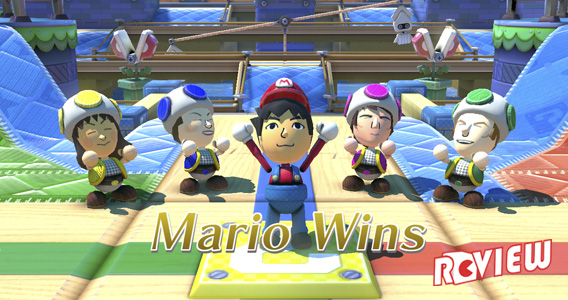
Not unlike an exotic space parasite, Nintendo Land wants to keep me alive so that it can feed on me. It needs some piece of me to populate its virtual space, and I need to keep playing it to see what happens next.
It all starts off rather innocently as one checks into the Plaza and meets Monita, the robotic guide that lays down the rules for each of the park’s attractions, shortly thereafter cutting players loose to explore the twelve different games Nintendo offers as a gateway to understanding the relationship between your television and the Wii U gamepad. Playing these games then rewards players with coins, which can be spent on another game in the attempt to win objects that are displayed throughout your park.
And then Nintendoland does something new for Nintendo, offering players the chance to throw open the doors of their park to an online community, sorta. The act causes crowds of foreign Miis to wander around that space. Regardless of where other players are, copies of their avatars are walking through countless parks, their greeting messages displayed overhead to show everything from Zelda sketches to one Mii’s clever message “Has anyone seen my kids?”
Suddenly I’m moving through the park to read each blurb in some strange social console experiment, and despite every legitimate word against Nintendo’s long standing resistance to online gaming, the signature charm of the company’s designs have come from behind to offer something that grasps the online space in ways few of us could have anticipated.
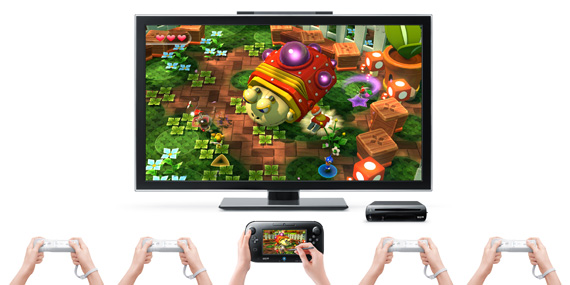
I’ve spent a few months avoiding Nintendo Land at various events, convinced that I understood the idea of mini-games, and though ready to agree that the few Nintendo kept showing were cute enough, certain that the game was falling far short of the Wii Sports challenge – delivering a game that makes immediate sense of the hardware for anyone who picks it up.
With the Wii-Mote in your hand and Wii Sports loaded, all you have to do is swing your hand and find your simple gestures swinging a tennis racket or tossing a bowling ball down the lane to score a strike. As Nintendo Land started and Monita began explaining the virtual amusement park to me, I remained convinced that I wasn’t going to enjoy my time here.
But somewhere between taking the first few steps into the attractions and opening my park to the online sphere, I was wrong.

There are six attractions within Nintendo Land meant for immediate solitary play, though a train ride later in the game opens these up to competition. All six of these offer a very simplistic invitation like games of old, which Nintendo can then layer an increasing level of difficulty over to find me investing an obscene amount of time pursuing some imaginary goal line in games tapping a nostalgic ability to stretch on endlessly.
Takamaru’s Ninja Castle is probably the best example of this strategy, asking players to turn the gamepad sideways and swipe their finger across the screen to throw ninja stars at enemies. It’s immediately easy to hit the brightly colored foes, and as such, they begin hiding throughout the scenery and throwing back weapons of their own, which can be cut down with more ninja stars. That players need to flip the gamepad upward to reload their fifty ninja star stash helps put a perspective on just how quickly the game has you tossing them in every direction.
I fell into Balloon Trip Breeze much the same way, meaning to only take a short trip with the game, which straps your Mii to two balloons and uses the touchscreen to create wind gusts to direct your Mii’s lift and flight direction. It’s essentially an object collecting game that, once again, simply layers in obstacles along the way to keep me pushing just a little further to see what it might do next.
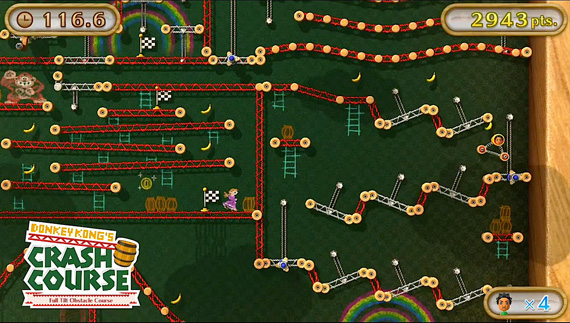
Yoshi’s Fruit Cart employs the same strategy, wherein players draw a line between Yoshi’s start point and a doorway, which sounds terribly simplistic. What players are attempting to do is gobble up fruit along the way, being shown the fruit on the television and attempting to draw the correct path that will take them over those and toward the door at the same time. The trick is that you can’t see them on the touchscreen, and need to use the background pattern seen on the TV and gamepad to line up the trip. Naturally the game will introduce pitfalls, and begin moving the background and the fruit to make this task more difficult.
The weakest link in the solitary minded attractions is Captain Falcon’s Twister Race, though it works far better than I expected. Players again turn the gamepad sideways, tilting the pad to guide their racer around bends and obstacles while attempting to hit speed pads. The tilt controls prove more effective in Donkey Kong’s Crash Course, where a cart is guided by tilting the screen to help it roll through complex levels while hitting buttons to trigger new pathways.
And then there’s Octopus Dance, which turns up to offer a familiar and addictive rhythm game of all things.

Three more of Nintendo Land’s attractions offer a team challenge, and in allowing for teams of one to five players, also give more game sessions to sample when no one else is around. Zelda Battle Quest, Metroid Blast, and Pikmin Adventure all offer stage based play inspired by their franchises, not only offering short and unique opportunities to play with elements of those franchises, but creating much larger games than one might expect. The chance to jump into Samus’ signature ship and blast space critters offers the most aggressive use of the gamepad, moving the pad to shift perspective while manipulating the analog sticks to control direction and still requiring two thumbs to zoom and shoot via the triggers.
Pikmin Adventure really stands out here however, offering an ideal pocket version of the series. A single-player recieves a squad of Pikmin as well as an assistant Mii, and then just flat out plays Pikmin on small stage levels, battling creatures by throwing Pikmin to attack and collecting dew to level up strength and numbers. It may make you long for the release of Pikmin 3, but it’s also a surprisingly strong game on its own and could easily have expanded to offer a portable release on the 3DS.
Three competitive games offer activities for groups of two to five players. Luigi’s Mansion has up to four players searching for the ghost player on the gamepad, who is trying to scare them to win. Animal Crossing Sweet Day and Mario Chase require players to hunt another down, with the hunted able to see a different view on the gamepad then those left looking only at the TV.
I want to go back to the idea that this isn’t Wii Sports, and lacks that instant comprehension, because when players emerge from these activities, they will have gained an immense amount of insight into the relationship of the gamepad to the television, not by instantly engaging in singular and simplistic activities, but by falling down a rabbit hole that keeps pulling them through toward an opening where everything becomes clear. This strategy may not bring in as many as the Wii did, but those who open the Wii U and visit Nintendo Land for any stretch of time will walk away with a greater clarity regarding a system that has been legitimately difficult to understand leading into its release.
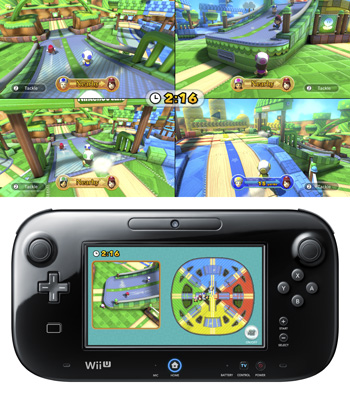
Recently I’ve spent the most time in Nintendo Land simply people searching, reading little text bubbles from other people’s Miis and perhaps checking out their profile in MiiVerse if I am intrigued by what I see – it’s already clear that the Wii U has an abundance of ridiculously talented artists scribbling drawings across the MiiVerse.
Maybe being taken by some art leaves you feeling encouraged to send out some friend requests, maybe not. It’s a different relationship from what we’re used to elsewhere, where relationships are only formed through consoles via direct play sessions. But even then, I rarely consider who might be sharing in a game online unless they are someone already on my various friend lists, almost always added based on some pre-existing relationship outside of the console.
There something more about the act of expression in this space, about catching the attention of others through the brief expression of the self. And there’s something very fresh there too, acknowledging the way a lot of relationships are formed outside of gaming. Where a momentary impression could spawn a friendship, or just as easily be appreciated for a moment and then forgotten. It’s something completely unique to Nintendo’s new hardware, and perhaps something many will write off at first. But you probably shouldn’t.
I mean somewhere out there, my Mii is wandering other parks, meeting people while I’m sitting here.
And at the same time, it doesn’t make a lot of sense, and it’s a bit baffling to know what to make of this new MiiVerse, which will inevitably stretch and grow to take on new shape. But it has a strange forward looking personality that expresses itself strongly within Nintendo Land, and comes together to show that this system is more than just the sum of its launch titles, that any console going forward is more than a single game.
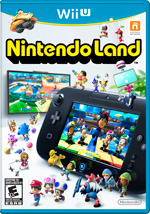
Played this at EGExpo back in september, and my reaction was kinda meh. Dont get me wrong, i can see what they’re doing, and each of those small games is prolly more fun than 95% of the iOS apps I have, but this is the kind of game where I know I’d never get the most out of it, and not through any minigame based animosity!
Like, I can see it being a really fun party game if you have a buncha nintendo friends ( or are 10 years old ) but I dont see anyone I know really getting into it.
How does it hold up alone? Does the online component provide enough to satisfy solo play, like leaderboards or whatever?
Comment by AngelosLH — November 21, 2012 @ 9:37 am
Great question. The leaderboard is a departure from what were used to, ie there is no giant board showing you the leaders for each game’s score, time etc. Instead, you can touch any of the Miis walking around your park and you’ll immediately see all of their accomplishments in the game – stamps are like achievements earned in the games, overall progress through the games, total coins collected etc.
I came at the mini-games the same as you, I mean I can turn on an iOS title without walking through a park – though Nintendo Land will give you a quick access feature to save the walking if you want. I don’t often have a parade of people through the house so playing solo is important, and so with Pikmin and Metroid it was great that it had a solitary set of missions as well as the multiplayer.
It’s deceptive to call them mini-games in many ways, even with simplistic objectives the depth Nintendo digs for each is something only a precious few iOS titles do really well. Also the gamepad has analog and face buttons so there’s a lot more play options to explore. But for solo play, there’s no one game I turn it on for, more of running between attractions, people searching, and dressing up the park in complete A.D.D mode. Maybe that’s important, cause I’m never long for turning off a single small game on a mobile device, but there I just run to another, and then another.
This help at all?
Comment by Jamie Love — November 21, 2012 @ 10:42 am
Hmm, this has changed how I view it a little, it seems like the attraction is as much wandering around a virtual theme park as it is playing games? Kinda like habbo hotel or PSHome, or hell, like an MMO but for small games? Be interesting to see what they learn from this, If this is building towards a motherfuggin 3D pokemon game where wander round a pokemon plaza and battle people: yes plz :p
Comment by AngelosLH — November 21, 2012 @ 12:04 pm
It is, and I expected that to be lame when seeing it at E3. But it’s very different when it’s your Mii, and you start bumping into the other Miis invading your space.
Also thanks, now I’m gonna fantasize about online pokemon all damn day <3
Comment by Jamie Love — November 21, 2012 @ 12:12 pm
Its stuff like this which peels back to revel a little of the magic that goes on in Nintendo, one could almost see the evolution of it from stuff like that one cat whose face you draw on in Animal Crossing, almost like a test which led to this kind of thing.
I’ve been playing Luigis Mansion lately and that did a similar thing- you can tell that the game relies heavily on the base mechanics of boos, then expands on that in a direction I didnt really expect once I got past the first few action sections!
So much goddamn creative flow going on over there at ninty, makes it super exciting to wonder where they’re gonna go next, what little experiment theyre gonna expand on. Pushing the path forwards and not giving a crap about copying what everyone else is doing cuz they got so many of their own damn mechanics to play with <3
Comment by AngelosLH — November 21, 2012 @ 12:25 pm